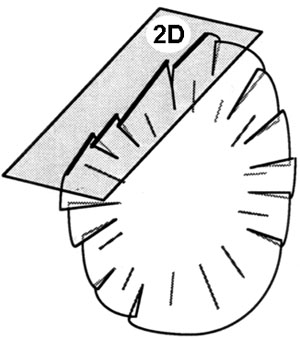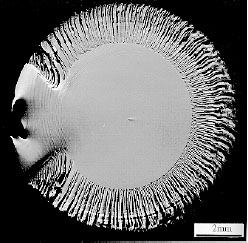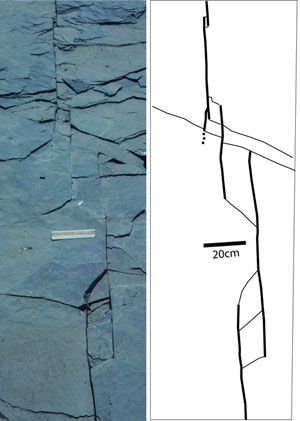| |||||||||
|
|
|||||||||
|
|
|||||||||
| Components of Joints | |||||||||
|
Joints are commonly made up of multiple segments (Pollard and Aydin, 1988), each of which may be considered a component of the whole. One mechanism for this geometry is related to joint propagation under mixed mode I-III loading (Figure 1 and Figure 2). The so-called twist hackles in various scales ultimately define joint segments which are linked to a common initial body and initiation point. This is considered in detail under joint propagation and joint breakdown. There are other mechanisms resulting in closely-spaced, interacting joint segments (Figures 3 and 4). Figure 3 shows a photograph and drawing of a joint composed of several segments on a pavement of thinly bedded siltstone without merging into a common continuous joint body at depth. Also see 'Echelon Joints' and 'Mechanisms and Mechanics of Echelon Joints' for other configurations and their formation mechanisms.
The term, composite joint, has been used in the literature (Helgeson and Aydin, 1991) for vertically aligned but discrete segments (Figure 4), each of which may be considered a component of the whole. Here, the segmentation is due to beds of various properties and their interfaces. For example, shales, even as thin as a lamina, are known to impede crossing of joints. There is evidence that joints in competent rocks on either side of thin shale layers are able to feel the presence of each other and the older ones may influence the location of the younger ones.
| |||||||||
| Reference: |
|||||||||
| Helgeson, D., Aydin, A., 1991 Pollard, D.D., Aydin, A., 1988 Sommer, E., 1969 |
|||||||||
|
Readme | About Us | Acknowledgement | How to Cite | Terms of Use | Ⓒ Rock Fracture Knowledgebase |
|||||||||



